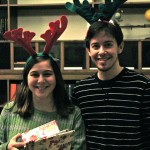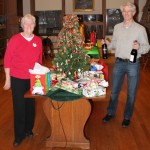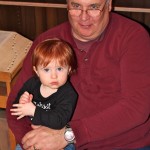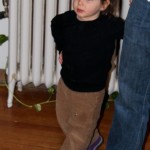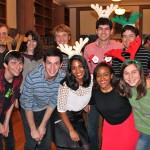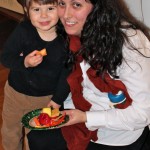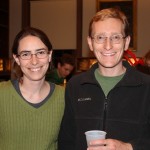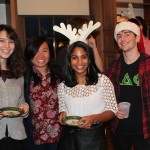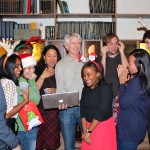The 26th Annual Undergraduate Research Symposium of the Keck Northeast Astronomy Consortium (KNAC) was held at Williams College on Saturday, Oct. 17, 2015, and Wesleyan was well represented! Six students presented results of their summer research: Julian Dann, Aylin Garcia Soto, Cail Daley, and Girish Duvvuri gave oral presentations while Rachel Aronow and Avi Stein presented a poster. Several other students came along to enjoy the weekend, which featured a dinner and social event on Friday night, the seminar on Saturday and breakout sessions on such topics as Inclusive Astronomy and how/why to program in Python. Over 100 students and professors from KNAC attended and a good time was had by all!
Uncategorized
First Light for Refurbished 20-inch Refractor!
Last night the Astronomy faculty and staff were treated to spectacular views of our favorite objects through the fully refurbished 20-inch Clark refractor! The telescope performed flawlessly and views of the Ring Nebula, Andromeda, Uranus, a couple of globular clusters, Albireo, etc. were breathtaking. The computer control quickly and accurately slews the telescope to objects selected by name, seamlessly flipping it to the appropriate side of the pier. It is a wonder to watch and to look through. The telescope will be open to the public on Homecoming Weekend and we will be establishing a regular schedule of public events with it in the months to come. Congratulations and many thanks to Roy Kilgard and Fred Orthlieb for seeing this all through! Thanks also to our many generous donors and supporters inside and outside the University.
E. Myles Standish, Wesleyan Astronomy MA ’62 Receives Distinguished Alumni Award
E. Myles Standish Jr. ’60, MA ’62
![[E. Myles Standish Jr. ’60, MA ’62 ]](http://wesconnect.wesleyan.edu/s/1318/images/editor/inpage/standish_myles.jpg)
Myles Standish, a Mathematics major and Astronomy MA graduate spent most of his professional career at the California Institute of Technology’s NASA Jet Propulsion Laboratory (JPL), creating and continually improving high-precision planetary ephemerides (orbital positions) vital to the successful navigation of planetary spacecraft. Those ephemerides are now the world’s standard, providing data to virtually all of the national almanac offices, astronomical researchers, and observatories.
A recognized leader in his field, Dr. Standish has been chairman of the American Astronomical Society’s Division on Dynamical Astronomy (AAS/DDA) and president of the International Astronomical Union’s Commission 4 (Ephemerides). He received the AAS/DDA Brouwer Award in 2000 and NASA’s Distinguished Service Medal in 2008. Asteroid “3420 Standish” is named in his honor.
Dr. Standish maintains that Wesleyan pointed him toward mathematical astronomy when its first computer was squeezed through the basement window of Van Vleck Observatory. He followed bachelor’s and master’s degrees here with a PhD at Yale University.
Father of three sons, Dr. Standish later volunteered for 25 years with the American Youth Soccer Organization as a game scheduler, regional commissioner, chief referee, and coach. In recognition of his contributions, the city of Pasadena hosts the annual Myles Standish Thanksgiving Tournament. He also was an active member of the local YMCA and of his sons’ high school booster club.
Dr. Standish is now retired and lives with his wife on the shore of Lake Keowee in South Carolina. He is involved with community affairs and gives lectures on a wide variety of topics through the Osher Lifelong Learning Institute at Clemson University. He also continues to referee professional papers, answer questions on astronomy, and fulfill computing requests from astronomers around the world.
Rain or Shine Space Nights at Wesleyan
Starting on February 4th, 2015, the Van Vleck Observatory at Wesleyan University will be opening its doors to the public every Wednesday night, rain or shine, for a series of space nights. Come talk to students and faculty about the latest space-related discoveries by scientists at Wesleyan and around the world. For the spring semester, the events will start at 8pm, beginning with a half-hour interactive presentation by students and/or faculty, followed by a chance for everyone to see the sky through Wesleyan’s telescopes (weather permitting). Presentations are intended to be accessible to visitors of all ages, although aimed primarily at high school level and above. A series of monthly kids’ nights is in the works as well. For more information and a schedule of events, check out the Astronomy department website at www.wesleyan.edu/astro/events or follow us on Twitter at @WesAstro .
To stay informed about all the latest Astronomy events at Wesleyan, sign up for our mailing list here: http://goo.gl/forms/mywuNrT0Nh
VVO 20″ Restoration Update
The dust has settled and restoration work for the summer is nearly complete. Our two excellent summer students, Becca Hanschell (’16) and Julian Dann (’17), spent 10 weeks disassembling, cleaning, and painting under the supervision of antique telescope expert Fred Orthlieb. You can see pictures and lots of time-lapse video on our twitter feed and youtube channel.
As of August 9, both axles and the OTA joiner have been remounted on the telescope pier. Almost all of the cleaning and painting has been done. We have sourced the parts for the new drives and telescope control system and will be acquiring those over the coming months. This is a time of careful thought as we design, build, and acquire new parts. We’re designing the system with the goal of another century or more of operation.
In the coming weeks, we will be announcing details about the VVO Centennial Celebration. Stay tuned!
VVO Refractor Restoration!
We are pleased to announce that the historic Van Vleck Observatory 20″ Alvan Clark refractor is undergoing an extensive restoration project in anticipation of the Centennial of VVO, which we will be celebrating throughout the 2015-16 academic year. Stay tuned for more details about that soon.
For a description of the restoration, see the links below. The best way to keep up to date is to follow us on twitter: @WesAstro. We’re posting pictures and frequent updates. We’re also posting daily time-lapse videos of the restoration to our YouTube channel.
Sturm Lecture Events
Every year, the Astronomy Department is lucky enough to host a prestigious member of the astronomical community for a day or two of astronomical events. The events are centered around a public lecture which draws hundreds of attendees each year. This year, we are thrilled to welcome Professor Meg Urry from Yale and President-elect of the American Astronomical Society. You can read a bit more about her public talk at the Sturm Lecture page. There will be multiple opportunities to hear Professor Urry speak over the next couple of days, and we hope you will join us for some (or all!) of them.
Wednesday, 4/2, 4pm, in Exley 058
WesWIS/Astro talk: “Women in Science: Why so Few?”
Click for Event Details
Wednesday, 4/2, 8pm in CFA Hall
Sturm Lecture: “Black Holes, Galaxies, and the Evolution of the Universe”
Click for Event Details
Thursday, 4/3, 12pm in Woodhead Lounge
The Center for Faculty Career Development will host a conversation with Prof. Urry about inclusive pedagogy in the sciences. This event is open to faculty, post-docs, and grad students.
Email: cfcd@wes for details.
Thursday, 4/3, 4pm in VVO 110
Astro Colloquium: “The Co-Evolution of Black Holes and Galaxies over Cosmic Time”
Click for Event Details
Wesleyan Students Attend Astronomy Conference at Vassar College

Wesleyan astronomy students and faculty traveled to Vassar College for the 24th Annual Undergraduate Research Symposium of the Keck Northeast Astronomy Consortium (KNAC), held on October 25 and 26, 2013. About 85 astronomy faculty and students attended the one-day symposium, listening to talks by students at our institutions who did summer research projects in astronomy. KNAC is currently supported by an NSF grant to Wesleyan University. Member colleges are: Colgate, Haverford, Middlebury, Swarthmore, Vassar, Wellesley, Wesleyan and Williams.
In addition to the talks, we enjoyed a dinner and evening star party hosted at the Vassar College Observatory. Student speakers from Wesleyan were Junior Trevor Dorn-Wallenstein and Sophomore Jesse Tarnas. Also attending from Wesleyan were: Suwun Suwunnarat, Avram Stein, Girish Duvvurl, Maia Neiles-Sager, Julian Dann and Simon Wright, as well as Professors William Herbst, Meredith Hughes, Roy Kilgard and Seth Redfield.
- The student speakers at the KNAC conference at Vassar.



Also presenting at the conference were KNAC students who worked at Wesleyan last summer, doing research under the direction of Wesleyan faculty. Four students from last summer gave talks. They were: Frankie Encalada from Broward College, who worked with Professor Meredith Hughes, Rachel Pedersen from Bates College who worked with Professor Bill Herbst, Alyssa Sokol from Colgate University who worked with Post-doc Adam Jensen and Estella de Souza from Bryn Mawr College who worked with Professor Seth Redfield. Will Harney of Union College presented a poster paper based on his summer research with Professor Meredith Hughes.





Ring Nebula with the 24″ Telescope
Last night the Introductory Astronomy (ASTR155) class took over the CCD imager on the 24″ telescope. We checked out a colorful binary star system, Albireo, through different filters and saw the stars change their relative brightnesses as we switched from blue light to red light (one star is redder and the other is bluer, because they are different temperatures). We also tried some 3-color observing with famous Messier objects, and were able to reconstruct a full-color image of the Ring Nebula. Here are two pictures from last night’s observing session: the first uses B, V, and R filters to approximate a true-color RGB image of the nebula, and the second uses a narrow-band Halpha filter to bring out the red color and structure of Hydrogen in the outer layers of the nebula (which works great, but with the unfortunate side effect that the background stars look blue!)












